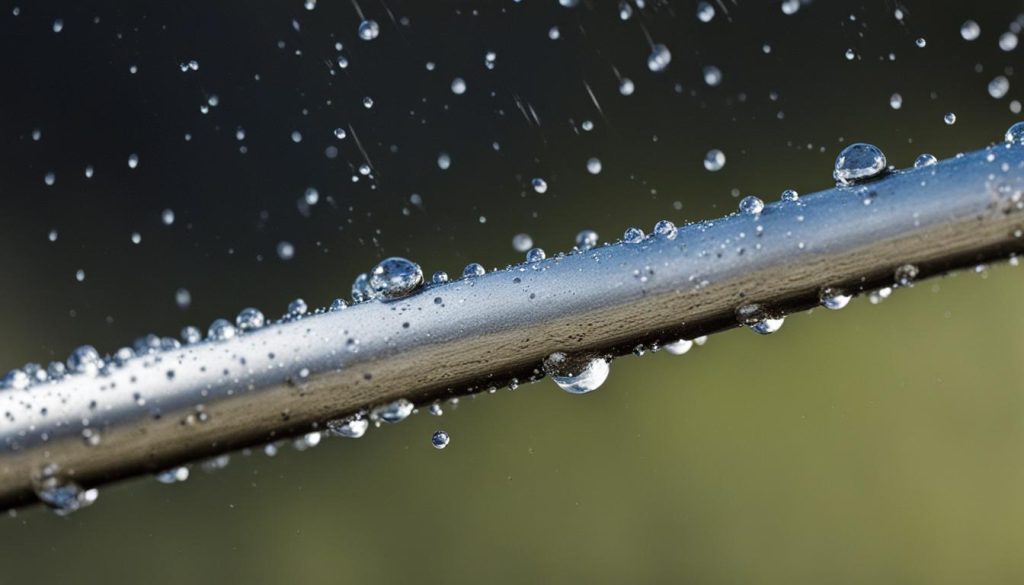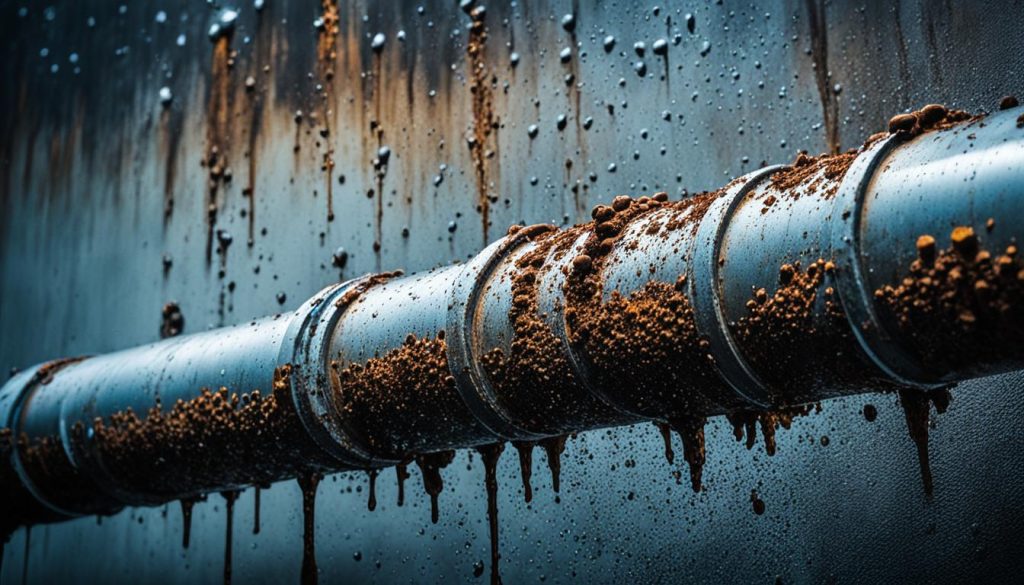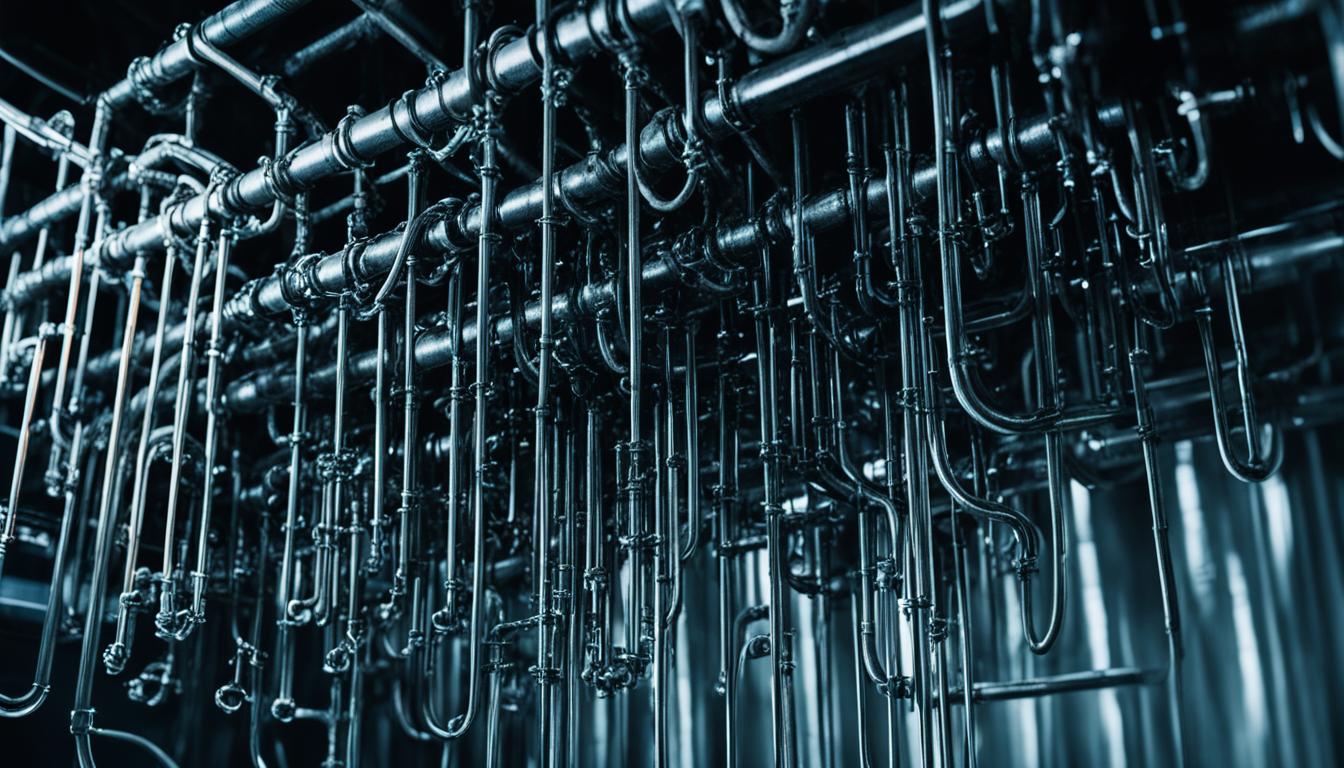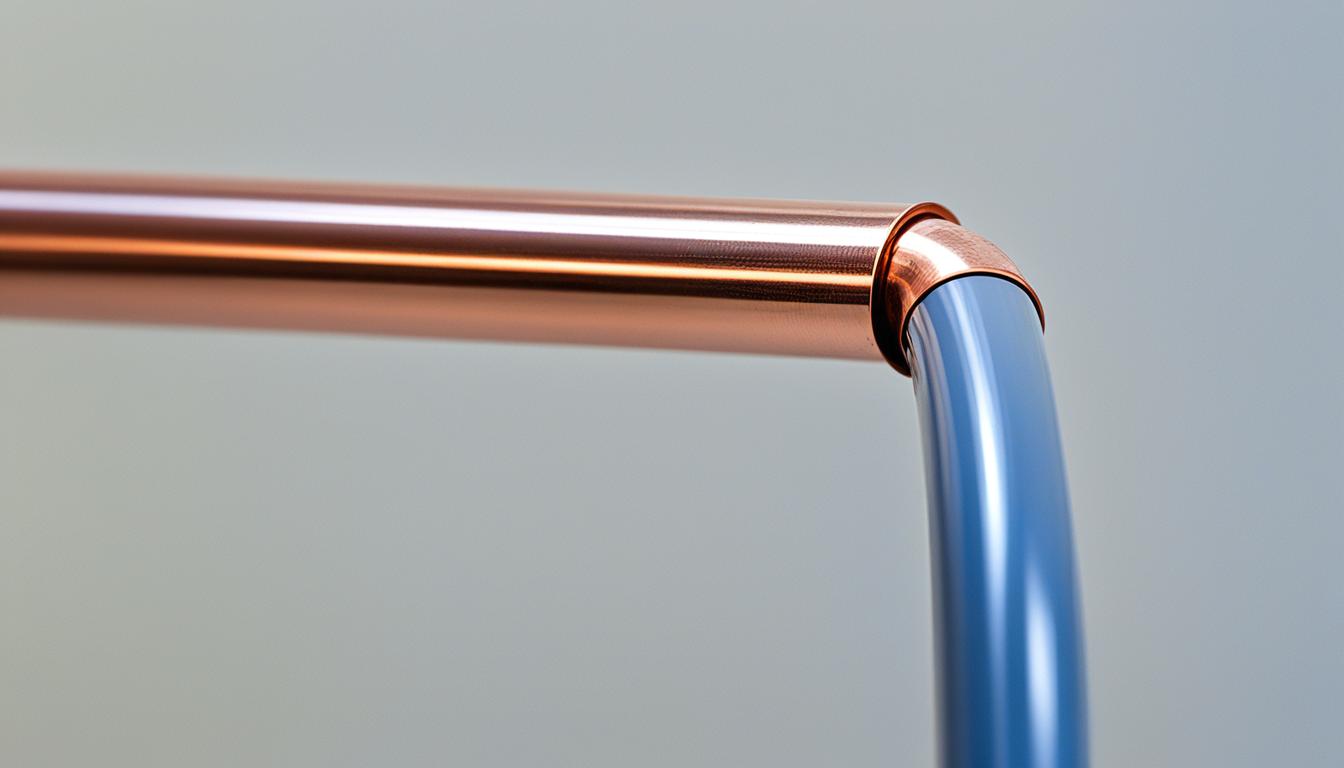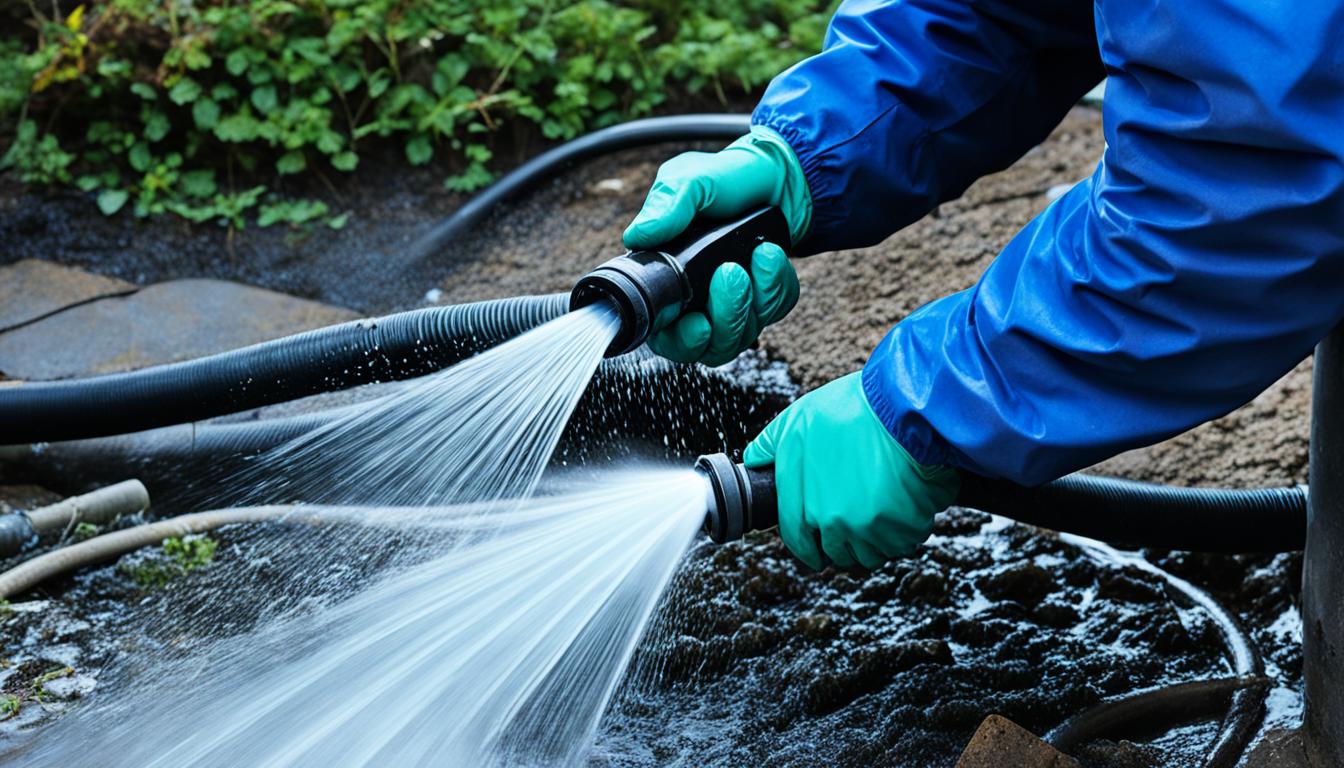Sweating Pipes Fix – Stop Condensation Now!
Did you know that sweating pipes can lead to serious damage if left untreated? The moisture buildup on pipes, also known as condensation, can cause corrosion, mold growth, and slippery surfaces. Protecting your plumbing from this issue is crucial for maintaining the integrity of your system and ensuring a safe environment.
In this article, I will explore the causes of pipe sweating and provide effective solutions to prevent condensation. By implementing these measures, you can avoid the risks associated with moisture on pipes and keep your plumbing system in optimal condition.
Key Takeaways:
- Moisture buildup on pipes, or condensation, can cause corrosion, mold growth, and slippery surfaces.
- Prolonged moisture on pipes should be addressed to prevent damage to the plumbing system and ensure a safe environment.
- Traditional insulation methods may not effectively prevent pipe sweating, requiring the use of specialized insulation.
- The best way to stop condensation on water pipes is to properly insulate them using insulation jackets specifically designed for this purpose.
- Proper insulation creates a thermal barrier, preventing warm air from coming into contact with the cold surface of the pipes.
Why Do Pipes “Sweat”?
Pipes do not actually sweat, but the moisture that forms on the outside of cold pipes is from the air. When humid air comes into contact with a cold pipe, the air loses its capacity to hold water vapor, resulting in condensation. This process is year-round and especially prevalent during the winter months when furnaces heat the air.
Condensation occurs when the temperature of the pipe surface drops below the dew point of the surrounding air. This causes the moisture in the air to form tiny water droplets on the pipe’s surface, leading to the appearance of “sweating” pipes. The moisture buildup on the pipes can create a damp environment that promotes the growth of mold and mildew if left unaddressed.
Controlling the moisture buildup on pipes is crucial to prevent potential damage and maintain the integrity of your plumbing system. Insulating pipes and implementing moisture control measures can help to minimize condensation and protect against corrosion.
Common Causes of Pipe Sweating
There are several factors that contribute to pipe sweating and moisture buildup on pipes:
- High humidity levels: When the relative humidity in the air is high, there is more moisture available to condense on cold surfaces.
- Poor insulation: Insufficient insulation or gaps in insulation allow warm, humid air to come into contact with cold pipes, resulting in condensation.
- Cold water temperature: Cold water running through the pipes lowers the temperature of the pipes, increasing the likelihood of condensation.
- Drafts or air leaks: Drafts or air leaks near pipes can bring in warm, humid air, exacerbating the condensation issue.
Understanding the causes of pipe sweating is crucial for implementing effective solutions to prevent condensation. By addressing these underlying factors, you can minimize moisture buildup on pipes and protect your plumbing system from potential damage.
Preventing Pipe Condensation
To prevent condensation and minimize moisture buildup on pipes, consider the following measures:
- Proper insulation: Insulate both hot and cold water pipes using high-quality insulation materials. Ensure that the insulation is installed correctly and covers the entire length of the pipes.
- Control humidity levels: Use dehumidifiers or ventilation systems to reduce humidity levels in areas where pipes are susceptible to condensation.
- Eliminate drafts: Seal any air leaks or drafts near pipes to prevent warm, humid air from coming into contact with cold surfaces.
- Maintain temperature consistency: If possible, maintain a consistent temperature in areas where condensation occurs to minimize temperature differentials that contribute to the formation of condensation.
- Regular maintenance: Regularly inspect your plumbing system for signs of condensation or moisture buildup. Repair any leaks or damaged insulation promptly.
By implementing these preventative measures, you can effectively minimize pipe sweating and reduce the risk of damage caused by moisture buildup on pipes.
Is It Normal for Pipes to Sweat?
Condensation on pipes, commonly known as pipe sweating, is a common occurrence in many homes and buildings. When cold water flows through pipes and comes into contact with warm, humid air, the difference in temperature causes moisture to form on the exterior of the pipes. This condensation can make the pipes appear damp or even cause small droplets of water to form.
It is important to note that some level of pipe sweating is normal and expected, especially in areas with high humidity. As the air temperature changes throughout the day, you may notice the amount of condensation on your pipes varying. However, prolonged sweating or excessive moisture buildup can lead to problems such as pipe corrosion, mold growth, and damage to surrounding materials.
To determine if the amount of sweating on your pipes is considered normal, it is essential to monitor the condensation level and take appropriate measures if necessary. If your pipes are consistently dripping with water or if you notice mold growth or signs of corrosion, it is recommended to consult a professional who can assess the situation and provide guidance on how to address the issue.
Proper insulation and moisture control techniques can help manage and prevent excessive pipe sweating. We will explore effective solutions and prevention methods in the following sections.
How Can You Tell if You Have Sweating Cold Water Pipes or Leaking Ones?
Identifying whether you have sweating pipes or leaking ones is crucial for addressing the issue promptly. By considering the location of the pipes and observing specific signs, you can determine the cause of the problem and take appropriate action. Here are some key factors to consider:
Identifying Sweating Pipes
If you suspect that your pipes are sweating due to condensation, pay attention to the following:
- Location: Sweating pipes are typically found in areas exposed to warm, moist air. Areas such as basements, crawlspaces, or bathrooms with poor ventilation are common hotspots for sweating pipes.
- Visible moisture: Look for water droplets or beads of moisture on the surface of the pipes. This is a clear indicator of condensation.
- Consistency: Sweating pipes will exhibit consistent moisture buildup, especially during periods of high humidity or when cold water is being used.
Detecting Leaking Pipes
In contrast to sweating pipes, leaking pipes require immediate attention to prevent further damage. Here are some signs to look for:
- Location: Leaking pipes are often found in cool areas, such as basements or utility rooms, where there is minimal exposure to warm, moist air.
- Pooling or dripping water: Look for standing water or water dripping from the pipes. If you notice continuous water accumulation or dripping, it is likely a sign of a leak.
- Water stains or discoloration: Check for water stains on walls, ceilings, or floors near the pipes. Discoloration can indicate an ongoing leak.
It’s important to note that while these signs can help you identify the issue, it’s recommended to consult a professional plumber for an accurate diagnosis and appropriate repairs.
Having a clear understanding of whether you have sweating pipes or leaking ones can guide you towards the right solution. Addressing the issue promptly will help you prevent further damage and ensure the longevity of your plumbing system.
| Signs | Identifying Sweating Pipes | Detecting Leaking Pipes |
|---|---|---|
| Location | Areas exposed to warm, moist air (e.g., basements, crawlspaces, poorly ventilated bathrooms) | Cool areas with minimal exposure to warm, moist air (e.g., basements, utility rooms) |
| Visible moisture | Water droplets or beads of moisture on the surface of pipes | Pooling or dripping water from the pipes |
| Consistency | Consistent moisture buildup, especially during high humidity or when cold water is being used | Continuous water accumulation or dripping |
| Water stains or discoloration | N/A | Water stains on walls, ceilings, or floors near the pipes |
Risks and Dangers of Condensation Caused Corrosion
Pipe condensation can have serious consequences for the safety and functionality of your equipment and facility. The presence of moisture on pipes can lead to corrosion, which poses significant risks. Corrosion weakens the integrity of metals, increasing the likelihood of equipment failure and structural issues.
One of the major safety hazards associated with pipe condensation is the creation of slippery surfaces. When moisture accumulates on equipment, it can create potentially dangerous conditions, significantly increasing the risk of falls and accidents in your facility.
To ensure a safe environment and prevent equipment damage, it is crucial to address and mitigate condensation on pipes. By taking proactive measures to manage condensation, you can minimize the risks of corrosion and equipment failure, protecting your assets and the safety of your personnel.
| Corrosion Risks | Dangers of Pipe Condensation | Equipment Failure | Safety Hazards |
|---|---|---|---|
| Metal degradation | Slippery surfaces | Malfunctioning machinery | Increased risk of falls |
| Structural integrity issues | Accidents and injuries | Costly repairs | Workplace hazards |
| Reduced equipment lifespan | Mold and mildew growth | Production downtime | Legal liabilities |
Why Traditional Insulation Methods Won’t Help
When it comes to preventing pipe sweating and condensation, traditional insulation methods may fall short. One common method is spray foam insulation, but it has its limitations. Let’s explore why these traditional insulation methods won’t provide effective long-term protection for your pipes.
Dropping the Ball on Repairs
One of the limitations of traditional insulation, such as spray foam insulation, is that it often gets removed during repairs and not properly replaced. This can leave gaps or areas without insulation, allowing condensation to affect the remaining insulation. These gaps create openings for moisture to seep in, leading to potential condensation issues and damage to your pipes.
A Losing Battle with Moisture
Another drawback of traditional insulation methods is that they can lose effectiveness when consistently exposed to moisture. Spray foam insulation, for example, may not hold up well in environments where humidity and moisture levels are high or fluctuate frequently. This can compromise its thermal barrier properties, making it less efficient in preventing pipe sweating and condensation.
If you want to ensure long-lasting protection against pipe condensation, it’s important to choose insulation methods that are specifically designed for this purpose and can withstand moisture exposure without compromising their performance.
Getting the Right Insulation
To effectively prevent pipe sweating and condensation, choosing the right insulation is crucial. Look for insulation options that provide a tight fit, ensuring there are no gaps or spaces for moisture to penetrate. Consider insulation materials specifically designed to create a thermal barrier, preventing warm air from coming into contact with the cold surface of the pipes.
One option to consider is the use of reusable insulation jackets. These jackets provide an excellent fit and offer protection against ambient air temperature and humidity. For example, Thermaxx Cold Insulation Jackets provide a snug fit and can be installed easily, ensuring optimal insulation coverage and condensation prevention.
| Traditional Insulation Methods | Spray Foam Insulation | Thermaxx Cold Insulation Jackets |
|---|---|---|
| May not be properly replaced during repairs, leaving gaps | Can lose effectiveness when exposed to moisture | Provides a tight fit, preventing gaps |
| May not offer long-term condensation prevention | May not hold up well in high humidity environments | Creates a thermal barrier to prevent warm air contact |
By selecting the right insulation method, you can ensure effective condensation prevention and maintain the integrity of your pipes for years to come.
The Best Way to Stop Condensation on Water Pipes
The most effective method to prevent condensation on your water pipes is by properly insulating them. Insulation acts as a protective layer that creates a barrier between the cold surface of the pipes and the warmer surrounding air, preventing the formation of condensation.
When it comes to insulating pipes, Thermaxx Cold Insulation Jackets are a reliable choice. These reusable insulation jackets are designed to provide a snug fit, ensuring that ambient air temperature and humidity do not impact the pipes. The insulation material used in these jackets traps air within its fibers, creating a thermal barrier that prevents warm air from coming into contact with the cold pipe surface.
Selecting the right insulation for your specific needs is crucial in effectively preventing condensation. Thermaxx Cold Insulation Jackets offer superior performance and durability, making them an ideal solution for long-term condensation prevention. By investing in proper pipe insulation, you can safeguard your plumbing system from moisture-related issues, including corrosion and mold growth.
Source Links
- https://www.familyhandyman.com/project/how-to-fix-sweating-pipes/
- https://blog.thermaxxjackets.com/best-way-to-prevent-chilled-pipe-sweating-or-condensation
- https://www.balkanplumbing.com/sweating-pipes-and-pipe-condensation-causes/
- Investing Wisely: How Windows & Doors in Boost Property Value and Financial Health - April 24, 2025
- The Financial Impact of Personal Injuries: Why Legal Help Matters for Business Owners - April 16, 2025
- The Hidden Financial Costs of Domestic Assault: What Business Owners Need to Know - April 16, 2025
